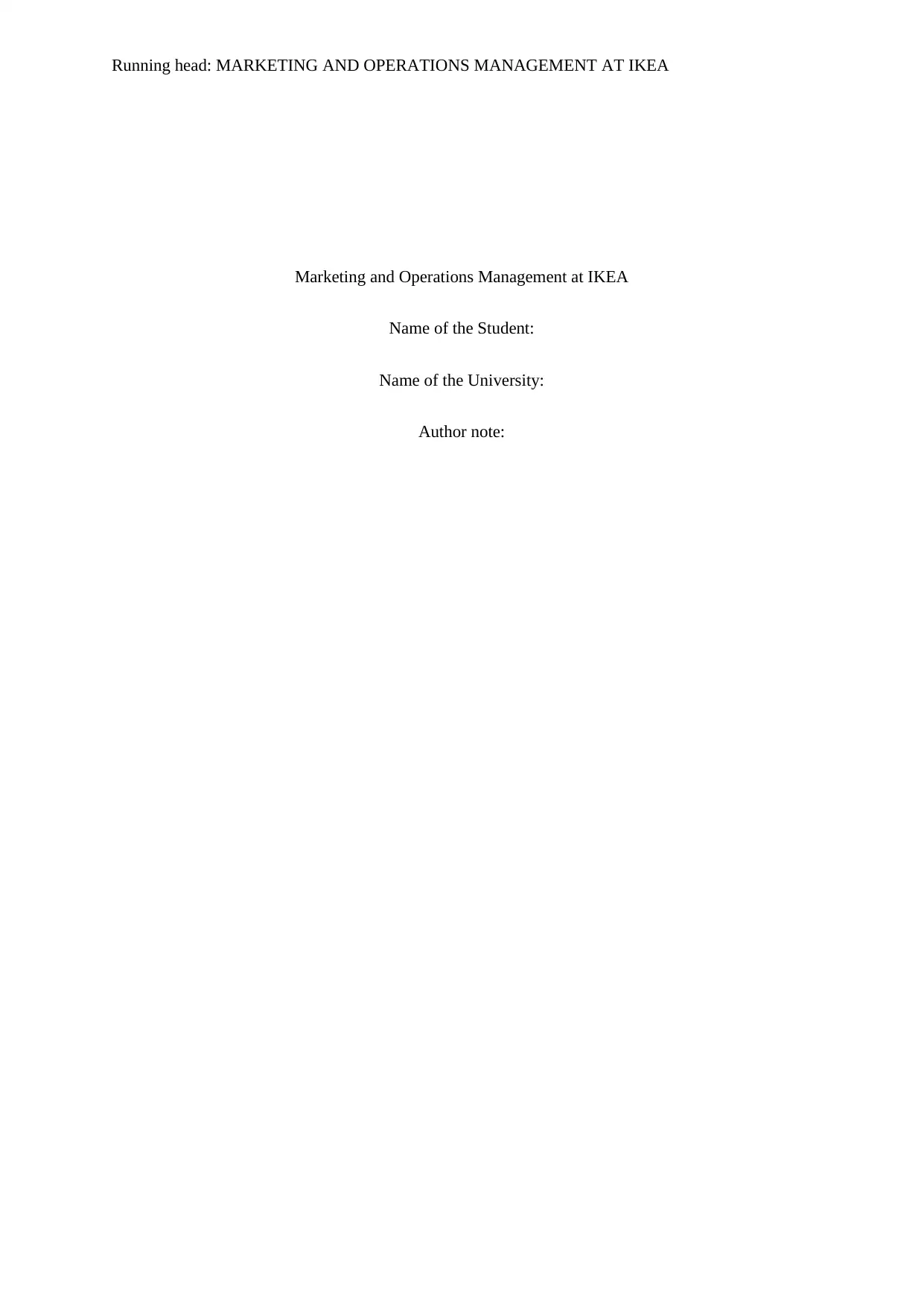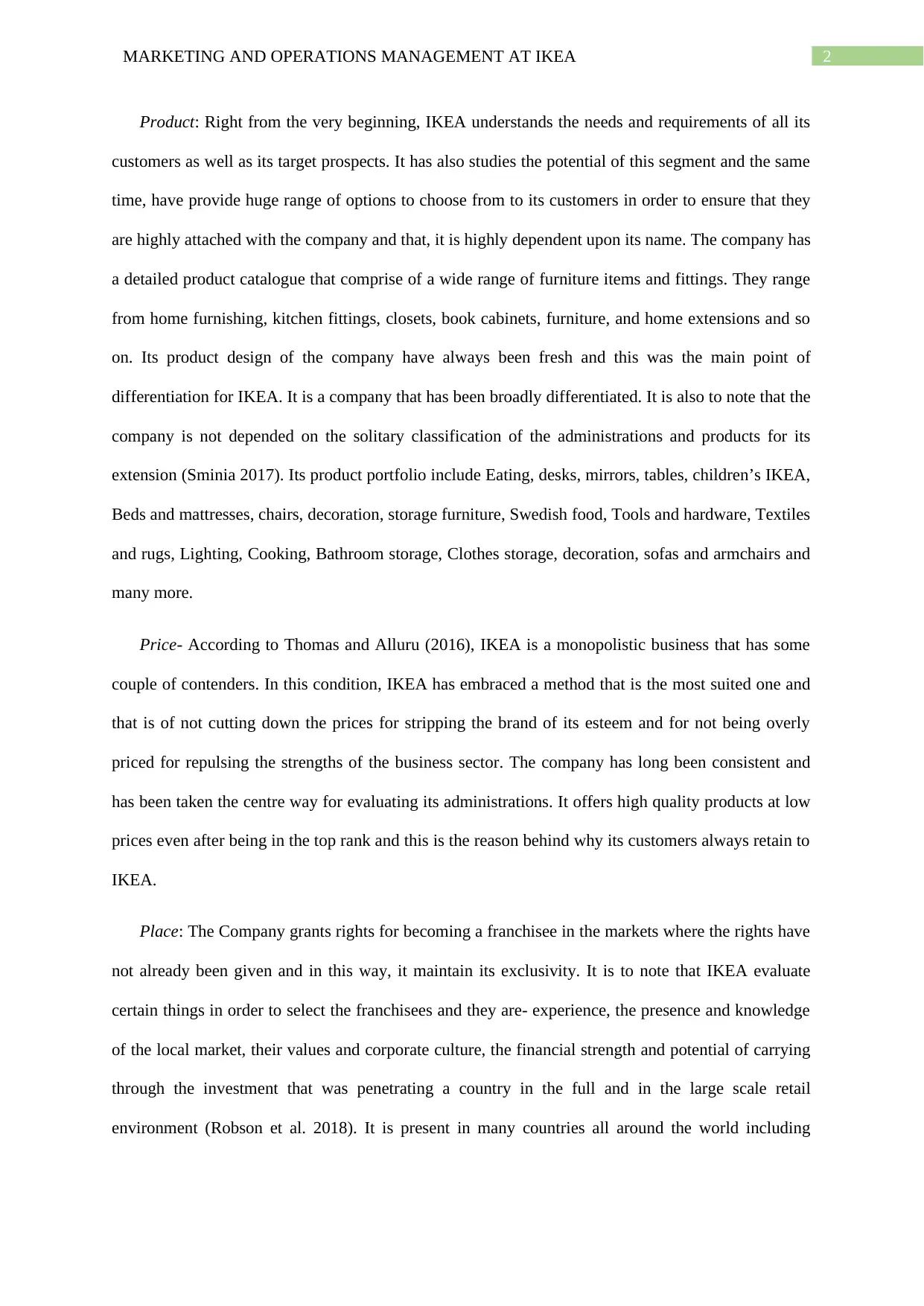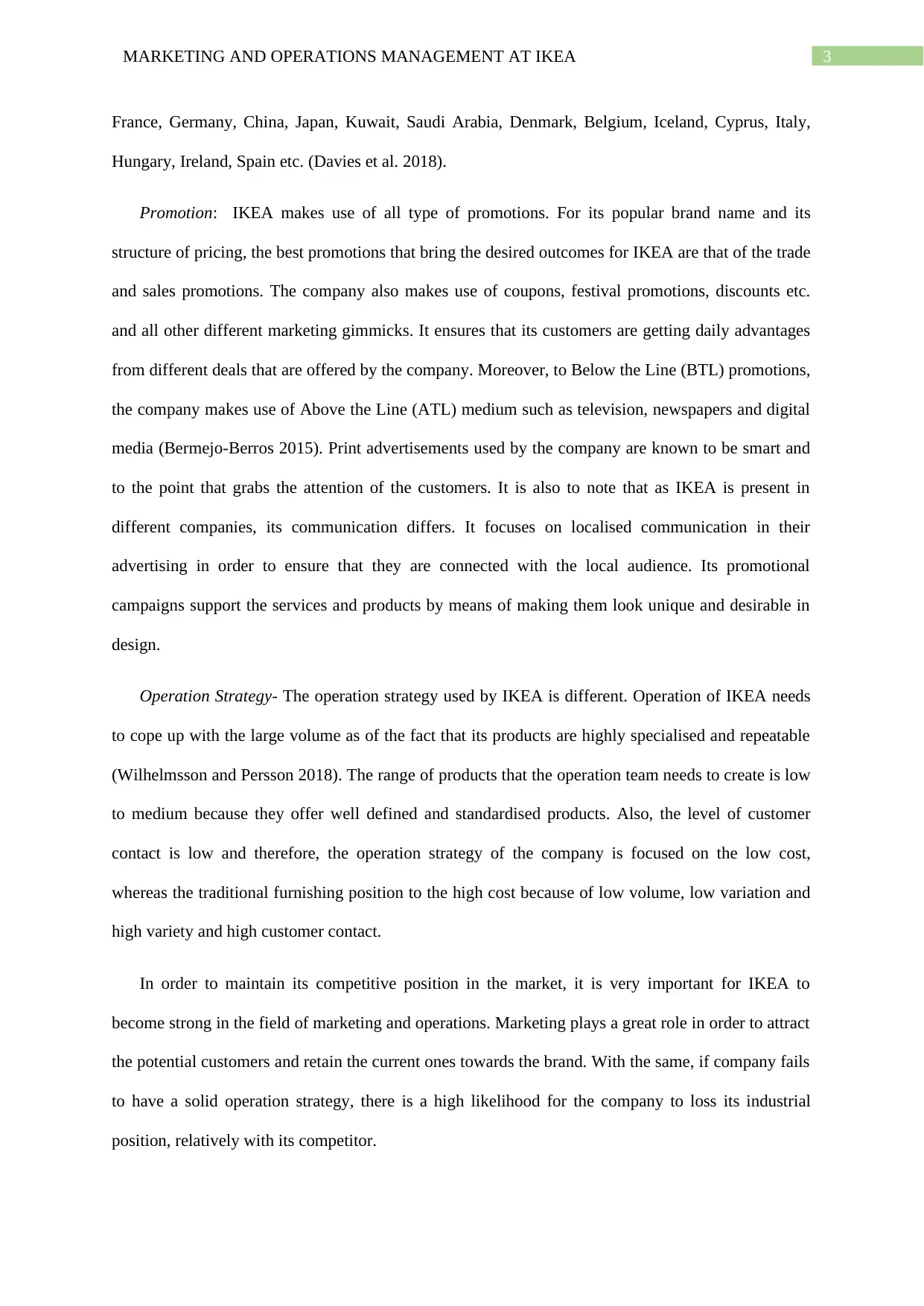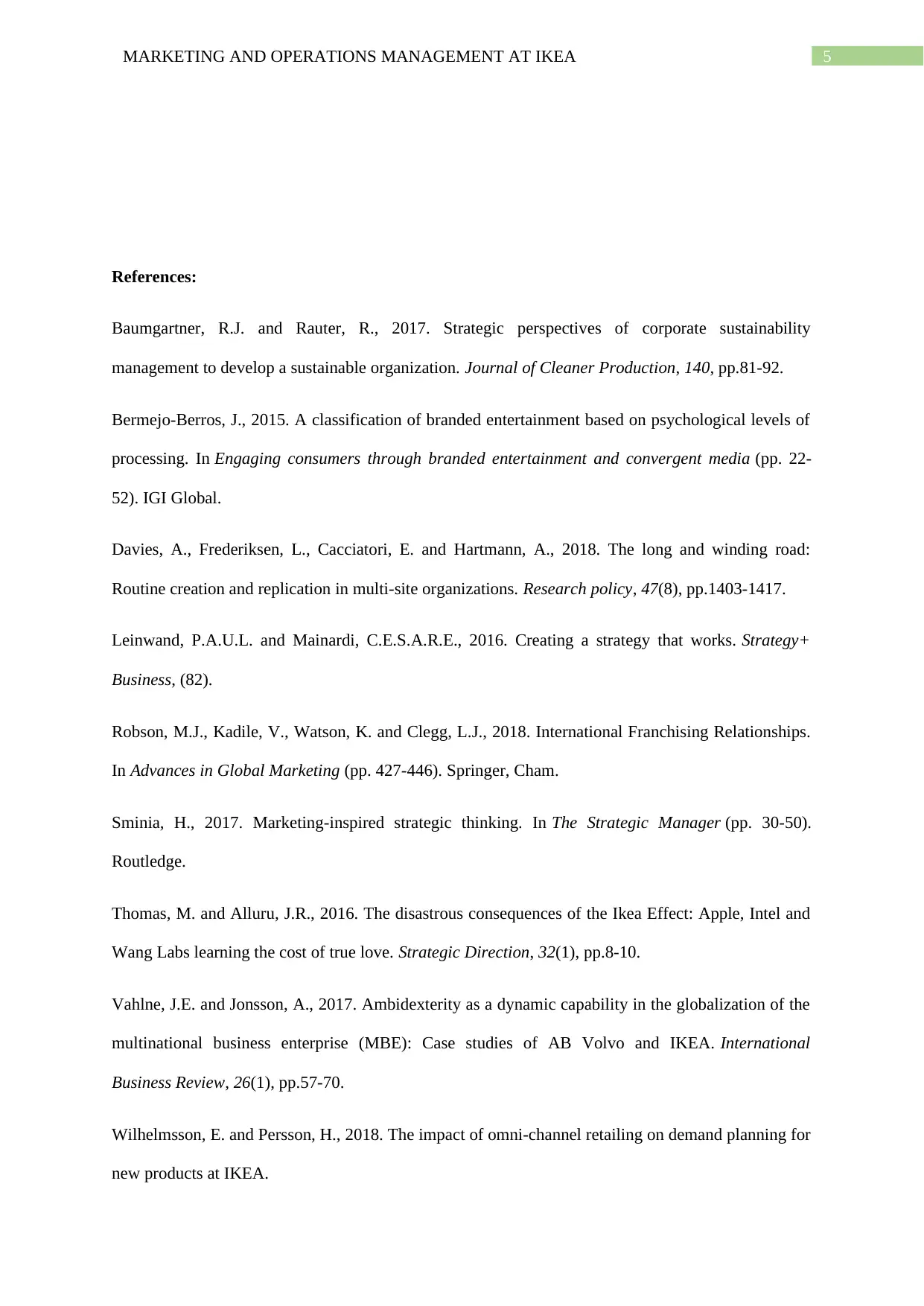Marketing and Operations Management at IKEA
VerifiedAdded on 2023/06/10
|6
|1708
|440
AI Summary
This paper discusses the competitive strategy of IKEA and how the marketing strategy and operations support it. The relationship between competitive, operations, and marketing strategy is also assessed.
Contribute Materials
Your contribution can guide someone’s learning journey. Share your
documents today.

Running head: MARKETING AND OPERATIONS MANAGEMENT AT IKEA
Marketing and Operations Management at IKEA
Name of the Student:
Name of the University:
Author note:
Marketing and Operations Management at IKEA
Name of the Student:
Name of the University:
Author note:
Secure Best Marks with AI Grader
Need help grading? Try our AI Grader for instant feedback on your assignments.

1MARKETING AND OPERATIONS MANAGEMENT AT IKEA
Introduction
IKEA is one of the Swedish furniture company, founded in the year 1943. Its mission is to
offer a broad range of home furnishing products and services to its customers all around the globe
along with excellent durability and quality at low prices in order to ensure that many people can
afford to buy them (Vahlne and Jonsson 2017). However, the company possesses some powerful
strategies for becoming a powerful competitor in its market. This paper is going to elaborate on
discussing about the competitive strategy of IKEA. With the same, it shall also assess how the
marketing strategy and the operations of this company supports the competitive strategy. The
relationship in between the competitive, operations and marketing strategy shall also be assessed in
this paper.
Discussion
Competitive Strategy- Competitive Strategy refers to the long term plan of a company for
gaining competitive advantage over its competitors present within the industry. According to
Baumgartner and Rauter (2017), it is aimed towards establishing a defensive position within the
industry and for obtaining superior ROI (Return on Investment). However, it is to note that IKEA
attains its competitive advantage under the cost leadership strategy by means of forming lowest
possible cost. Under the cost leadership strategy it reduced its costs at every level of the value chain
and then charge lower and competitive prices that further results in high profit margins for the
company. It cuts down the costs regularly and always asks its marker to seek the least possible costly
suppliers.
Marketing Strategy- It is to note that IKEA makes use of differentiated strategy for satisfying the
needs and requirements of the customers who seek for value for money home furnishing solutions
(Leinwand and Mainardi 2016). It has transformed itself to positioning itself as value based
positioning from being a mere product based one. The company targets two groups- the young adults
belonging from the low to middle income families and the other is the business customers. The
marketing mix for IKEA is presented below:
Introduction
IKEA is one of the Swedish furniture company, founded in the year 1943. Its mission is to
offer a broad range of home furnishing products and services to its customers all around the globe
along with excellent durability and quality at low prices in order to ensure that many people can
afford to buy them (Vahlne and Jonsson 2017). However, the company possesses some powerful
strategies for becoming a powerful competitor in its market. This paper is going to elaborate on
discussing about the competitive strategy of IKEA. With the same, it shall also assess how the
marketing strategy and the operations of this company supports the competitive strategy. The
relationship in between the competitive, operations and marketing strategy shall also be assessed in
this paper.
Discussion
Competitive Strategy- Competitive Strategy refers to the long term plan of a company for
gaining competitive advantage over its competitors present within the industry. According to
Baumgartner and Rauter (2017), it is aimed towards establishing a defensive position within the
industry and for obtaining superior ROI (Return on Investment). However, it is to note that IKEA
attains its competitive advantage under the cost leadership strategy by means of forming lowest
possible cost. Under the cost leadership strategy it reduced its costs at every level of the value chain
and then charge lower and competitive prices that further results in high profit margins for the
company. It cuts down the costs regularly and always asks its marker to seek the least possible costly
suppliers.
Marketing Strategy- It is to note that IKEA makes use of differentiated strategy for satisfying the
needs and requirements of the customers who seek for value for money home furnishing solutions
(Leinwand and Mainardi 2016). It has transformed itself to positioning itself as value based
positioning from being a mere product based one. The company targets two groups- the young adults
belonging from the low to middle income families and the other is the business customers. The
marketing mix for IKEA is presented below:

2MARKETING AND OPERATIONS MANAGEMENT AT IKEA
Product: Right from the very beginning, IKEA understands the needs and requirements of all its
customers as well as its target prospects. It has also studies the potential of this segment and the same
time, have provide huge range of options to choose from to its customers in order to ensure that they
are highly attached with the company and that, it is highly dependent upon its name. The company has
a detailed product catalogue that comprise of a wide range of furniture items and fittings. They range
from home furnishing, kitchen fittings, closets, book cabinets, furniture, and home extensions and so
on. Its product design of the company have always been fresh and this was the main point of
differentiation for IKEA. It is a company that has been broadly differentiated. It is also to note that the
company is not depended on the solitary classification of the administrations and products for its
extension (Sminia 2017). Its product portfolio include Eating, desks, mirrors, tables, children’s IKEA,
Beds and mattresses, chairs, decoration, storage furniture, Swedish food, Tools and hardware, Textiles
and rugs, Lighting, Cooking, Bathroom storage, Clothes storage, decoration, sofas and armchairs and
many more.
Price- According to Thomas and Alluru (2016), IKEA is a monopolistic business that has some
couple of contenders. In this condition, IKEA has embraced a method that is the most suited one and
that is of not cutting down the prices for stripping the brand of its esteem and for not being overly
priced for repulsing the strengths of the business sector. The company has long been consistent and
has been taken the centre way for evaluating its administrations. It offers high quality products at low
prices even after being in the top rank and this is the reason behind why its customers always retain to
IKEA.
Place: The Company grants rights for becoming a franchisee in the markets where the rights have
not already been given and in this way, it maintain its exclusivity. It is to note that IKEA evaluate
certain things in order to select the franchisees and they are- experience, the presence and knowledge
of the local market, their values and corporate culture, the financial strength and potential of carrying
through the investment that was penetrating a country in the full and in the large scale retail
environment (Robson et al. 2018). It is present in many countries all around the world including
Product: Right from the very beginning, IKEA understands the needs and requirements of all its
customers as well as its target prospects. It has also studies the potential of this segment and the same
time, have provide huge range of options to choose from to its customers in order to ensure that they
are highly attached with the company and that, it is highly dependent upon its name. The company has
a detailed product catalogue that comprise of a wide range of furniture items and fittings. They range
from home furnishing, kitchen fittings, closets, book cabinets, furniture, and home extensions and so
on. Its product design of the company have always been fresh and this was the main point of
differentiation for IKEA. It is a company that has been broadly differentiated. It is also to note that the
company is not depended on the solitary classification of the administrations and products for its
extension (Sminia 2017). Its product portfolio include Eating, desks, mirrors, tables, children’s IKEA,
Beds and mattresses, chairs, decoration, storage furniture, Swedish food, Tools and hardware, Textiles
and rugs, Lighting, Cooking, Bathroom storage, Clothes storage, decoration, sofas and armchairs and
many more.
Price- According to Thomas and Alluru (2016), IKEA is a monopolistic business that has some
couple of contenders. In this condition, IKEA has embraced a method that is the most suited one and
that is of not cutting down the prices for stripping the brand of its esteem and for not being overly
priced for repulsing the strengths of the business sector. The company has long been consistent and
has been taken the centre way for evaluating its administrations. It offers high quality products at low
prices even after being in the top rank and this is the reason behind why its customers always retain to
IKEA.
Place: The Company grants rights for becoming a franchisee in the markets where the rights have
not already been given and in this way, it maintain its exclusivity. It is to note that IKEA evaluate
certain things in order to select the franchisees and they are- experience, the presence and knowledge
of the local market, their values and corporate culture, the financial strength and potential of carrying
through the investment that was penetrating a country in the full and in the large scale retail
environment (Robson et al. 2018). It is present in many countries all around the world including

3MARKETING AND OPERATIONS MANAGEMENT AT IKEA
France, Germany, China, Japan, Kuwait, Saudi Arabia, Denmark, Belgium, Iceland, Cyprus, Italy,
Hungary, Ireland, Spain etc. (Davies et al. 2018).
Promotion: IKEA makes use of all type of promotions. For its popular brand name and its
structure of pricing, the best promotions that bring the desired outcomes for IKEA are that of the trade
and sales promotions. The company also makes use of coupons, festival promotions, discounts etc.
and all other different marketing gimmicks. It ensures that its customers are getting daily advantages
from different deals that are offered by the company. Moreover, to Below the Line (BTL) promotions,
the company makes use of Above the Line (ATL) medium such as television, newspapers and digital
media (Bermejo-Berros 2015). Print advertisements used by the company are known to be smart and
to the point that grabs the attention of the customers. It is also to note that as IKEA is present in
different companies, its communication differs. It focuses on localised communication in their
advertising in order to ensure that they are connected with the local audience. Its promotional
campaigns support the services and products by means of making them look unique and desirable in
design.
Operation Strategy- The operation strategy used by IKEA is different. Operation of IKEA needs
to cope up with the large volume as of the fact that its products are highly specialised and repeatable
(Wilhelmsson and Persson 2018). The range of products that the operation team needs to create is low
to medium because they offer well defined and standardised products. Also, the level of customer
contact is low and therefore, the operation strategy of the company is focused on the low cost,
whereas the traditional furnishing position to the high cost because of low volume, low variation and
high variety and high customer contact.
In order to maintain its competitive position in the market, it is very important for IKEA to
become strong in the field of marketing and operations. Marketing plays a great role in order to attract
the potential customers and retain the current ones towards the brand. With the same, if company fails
to have a solid operation strategy, there is a high likelihood for the company to loss its industrial
position, relatively with its competitor.
France, Germany, China, Japan, Kuwait, Saudi Arabia, Denmark, Belgium, Iceland, Cyprus, Italy,
Hungary, Ireland, Spain etc. (Davies et al. 2018).
Promotion: IKEA makes use of all type of promotions. For its popular brand name and its
structure of pricing, the best promotions that bring the desired outcomes for IKEA are that of the trade
and sales promotions. The company also makes use of coupons, festival promotions, discounts etc.
and all other different marketing gimmicks. It ensures that its customers are getting daily advantages
from different deals that are offered by the company. Moreover, to Below the Line (BTL) promotions,
the company makes use of Above the Line (ATL) medium such as television, newspapers and digital
media (Bermejo-Berros 2015). Print advertisements used by the company are known to be smart and
to the point that grabs the attention of the customers. It is also to note that as IKEA is present in
different companies, its communication differs. It focuses on localised communication in their
advertising in order to ensure that they are connected with the local audience. Its promotional
campaigns support the services and products by means of making them look unique and desirable in
design.
Operation Strategy- The operation strategy used by IKEA is different. Operation of IKEA needs
to cope up with the large volume as of the fact that its products are highly specialised and repeatable
(Wilhelmsson and Persson 2018). The range of products that the operation team needs to create is low
to medium because they offer well defined and standardised products. Also, the level of customer
contact is low and therefore, the operation strategy of the company is focused on the low cost,
whereas the traditional furnishing position to the high cost because of low volume, low variation and
high variety and high customer contact.
In order to maintain its competitive position in the market, it is very important for IKEA to
become strong in the field of marketing and operations. Marketing plays a great role in order to attract
the potential customers and retain the current ones towards the brand. With the same, if company fails
to have a solid operation strategy, there is a high likelihood for the company to loss its industrial
position, relatively with its competitor.
Secure Best Marks with AI Grader
Need help grading? Try our AI Grader for instant feedback on your assignments.

4MARKETING AND OPERATIONS MANAGEMENT AT IKEA
Conclusion
Hence, from the above analysis it is clear that IKEA uses cost leadership strategy by means of
producing lowest possible cost and makes use of differentiated strategy for satisfying the needs and
requirements of the customers. It has transformed itself to positioning itself as value based
positioning. It targets the young adults and the business customers. The operation strategy used by the
company also has the potential to cope up with the large volume of products that it produce.
Conclusion
Hence, from the above analysis it is clear that IKEA uses cost leadership strategy by means of
producing lowest possible cost and makes use of differentiated strategy for satisfying the needs and
requirements of the customers. It has transformed itself to positioning itself as value based
positioning. It targets the young adults and the business customers. The operation strategy used by the
company also has the potential to cope up with the large volume of products that it produce.

5MARKETING AND OPERATIONS MANAGEMENT AT IKEA
References:
Baumgartner, R.J. and Rauter, R., 2017. Strategic perspectives of corporate sustainability
management to develop a sustainable organization. Journal of Cleaner Production, 140, pp.81-92.
Bermejo-Berros, J., 2015. A classification of branded entertainment based on psychological levels of
processing. In Engaging consumers through branded entertainment and convergent media (pp. 22-
52). IGI Global.
Davies, A., Frederiksen, L., Cacciatori, E. and Hartmann, A., 2018. The long and winding road:
Routine creation and replication in multi-site organizations. Research policy, 47(8), pp.1403-1417.
Leinwand, P.A.U.L. and Mainardi, C.E.S.A.R.E., 2016. Creating a strategy that works. Strategy+
Business, (82).
Robson, M.J., Kadile, V., Watson, K. and Clegg, L.J., 2018. International Franchising Relationships.
In Advances in Global Marketing (pp. 427-446). Springer, Cham.
Sminia, H., 2017. Marketing-inspired strategic thinking. In The Strategic Manager (pp. 30-50).
Routledge.
Thomas, M. and Alluru, J.R., 2016. The disastrous consequences of the Ikea Effect: Apple, Intel and
Wang Labs learning the cost of true love. Strategic Direction, 32(1), pp.8-10.
Vahlne, J.E. and Jonsson, A., 2017. Ambidexterity as a dynamic capability in the globalization of the
multinational business enterprise (MBE): Case studies of AB Volvo and IKEA. International
Business Review, 26(1), pp.57-70.
Wilhelmsson, E. and Persson, H., 2018. The impact of omni-channel retailing on demand planning for
new products at IKEA.
References:
Baumgartner, R.J. and Rauter, R., 2017. Strategic perspectives of corporate sustainability
management to develop a sustainable organization. Journal of Cleaner Production, 140, pp.81-92.
Bermejo-Berros, J., 2015. A classification of branded entertainment based on psychological levels of
processing. In Engaging consumers through branded entertainment and convergent media (pp. 22-
52). IGI Global.
Davies, A., Frederiksen, L., Cacciatori, E. and Hartmann, A., 2018. The long and winding road:
Routine creation and replication in multi-site organizations. Research policy, 47(8), pp.1403-1417.
Leinwand, P.A.U.L. and Mainardi, C.E.S.A.R.E., 2016. Creating a strategy that works. Strategy+
Business, (82).
Robson, M.J., Kadile, V., Watson, K. and Clegg, L.J., 2018. International Franchising Relationships.
In Advances in Global Marketing (pp. 427-446). Springer, Cham.
Sminia, H., 2017. Marketing-inspired strategic thinking. In The Strategic Manager (pp. 30-50).
Routledge.
Thomas, M. and Alluru, J.R., 2016. The disastrous consequences of the Ikea Effect: Apple, Intel and
Wang Labs learning the cost of true love. Strategic Direction, 32(1), pp.8-10.
Vahlne, J.E. and Jonsson, A., 2017. Ambidexterity as a dynamic capability in the globalization of the
multinational business enterprise (MBE): Case studies of AB Volvo and IKEA. International
Business Review, 26(1), pp.57-70.
Wilhelmsson, E. and Persson, H., 2018. The impact of omni-channel retailing on demand planning for
new products at IKEA.
1 out of 6
Related Documents
Your All-in-One AI-Powered Toolkit for Academic Success.
+13062052269
info@desklib.com
Available 24*7 on WhatsApp / Email
![[object Object]](/_next/static/media/star-bottom.7253800d.svg)
Unlock your academic potential
© 2024 | Zucol Services PVT LTD | All rights reserved.





